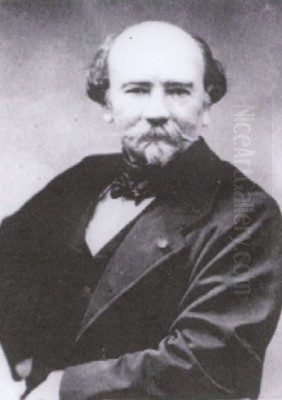
Charles Édouard Boutibonne stands as a notable figure in the landscape of 19th-century French Academic art. Though perhaps not as universally recognized today as some of his contemporaries who broke radically with tradition, Boutibonne carved a significant niche for himself, particularly with his refined portraits and genre scenes that captured the opulent spirit of Parisian high society, especially during the Second Empire. His work is characterized by meticulous detail, a delicate touch, and an unerring sense of elegance, reflecting the prevailing tastes of an era that valued technical skill and idealized beauty.
Early Life and Artistic Formation
Born on July 8, 1816, in Pest (now part of Budapest), Hungary, Charles Édouard Boutibonne was of French parentage. This French connection would prove pivotal in his artistic development and career. His early artistic inclinations led him to Vienna, a major cultural hub of the Austro-Hungarian Empire. There, he enrolled in the prestigious Academy of Fine Arts, where he had the invaluable opportunity to study under Friedrich von Amerling. Amerling, a leading Austrian portrait painter of the Biedermeier period, was renowned for his elegant and psychologically insightful portraits, and his influence likely instilled in Boutibonne a deep appreciation for refined execution and capturing the likeness and character of his sitters.
Seeking to further hone his skills and immerse himself in the vibrant heart of the European art world, Boutibonne moved to Paris. In the French capital, he continued his studies under the tutelage of Achille Devéria. Devéria was a versatile artist, known for his Romantic paintings, fashionable illustrations, and numerous portraits of prominent figures in the arts and literature, often executed as lithographs. His studio was a lively center, and exposure to Devéria's diverse output and his keen eye for contemporary fashion and social nuance would have further shaped Boutibonne's artistic sensibilities, particularly his ability to depict the fashionable elite. Achille's brother, Eugène Devéria, was also a significant figure in the Romantic movement, known for historical paintings like The Birth of Henry IV, and the artistic ferment of the Devéria circle would have been palpable.
Parisian Debut and Salon Success
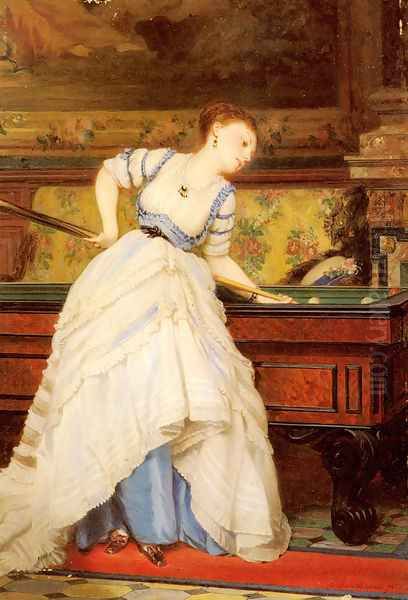
Boutibonne's formal training under such distinguished masters prepared him well for a career in Paris. He began to exhibit his works at the prestigious Paris Salon, the official art exhibition of the Académie des Beaux-Arts, which was the primary venue for artists to gain recognition and patronage. His debut at the Salon marked his entry into the competitive Parisian art scene.
His talent did not go unnoticed. As early as 1847, Boutibonne received a medal at the Salon, a significant acknowledgment of his skill and a testament to his adherence to the high standards of Academic painting. Throughout the 1860s, he became a regular and respected exhibitor. The Salon was not merely an exhibition; it was a major social and cultural event, and success there could make an artist's career. Artists like Jean-Léon Gérôme, William-Adolphe Bouguereau, and Alexandre Cabanel were dominant figures of the Salon, setting the standard for Academic excellence with their historical, mythological, and allegorical paintings, as well as their polished portraits. Boutibonne operated within this milieu, focusing on subjects that appealed to the tastes of the Salon juries and the affluent bourgeoisie.
The Height of a Society Painter: The Second Empire
The period of the Second Empire (1852-1870) under Napoleon III was a time of great prosperity and opulence in France, particularly in Paris. It was an era that celebrated luxury, fashion, and a vibrant social life. This environment provided fertile ground for artists like Boutibonne, who specialized in capturing the elegance and leisure of the ruling class and the wealthy elite.
Boutibonne became particularly renowned for his portraits of figures associated with Napoleon III's court. His ability to render luxurious fabrics, intricate details of costume, and the graceful demeanor of his sitters made him a sought-after portraitist. Among his most notable commissions were portraits of Empress Eugénie, the stylish and influential wife of Napoleon III. These portrayals were not just likenesses but carefully constructed images that conveyed status, refinement, and the fashionable ideals of the time. His work in this vein can be compared to that of Franz Xaver Winterhalter, the German painter who became the preferred portraitist of European royalty, including Empress Eugénie herself. While Winterhalter's portraits often possessed a grand, official air, Boutibonne's approach, though equally elegant, sometimes offered a slightly more intimate or genre-inflected view of his subjects.
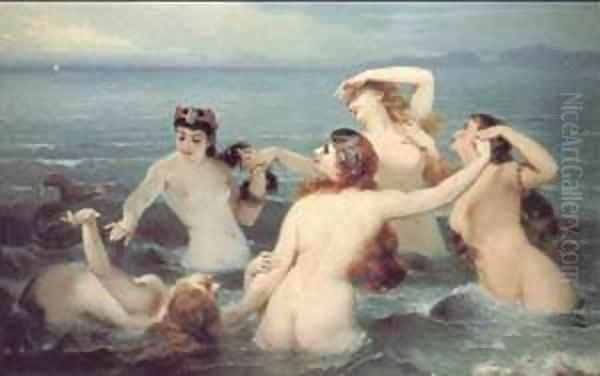
He also reportedly painted other royal figures, including Queen Victoria and Prince Albert of Great Britain, further cementing his reputation as a painter capable of navigating the highest echelons of society. These commissions underscore the international appeal of his polished style.
Artistic Style and Influences
Boutibonne's style is firmly rooted in the French Academic tradition. This tradition emphasized strong draftsmanship, a smooth and highly finished paint surface (the fini), idealized forms, and often, a narrative or anecdotal element. His figures are typically graceful and poised, their features rendered with a delicate precision. He paid meticulous attention to the textures of silks, satins, velvets, and lace, bringing a tactile quality to his depictions of fashionable attire.
His color palettes are generally harmonious and refined, often employing rich but controlled tones that enhance the sense of luxury. Compositions are carefully balanced, adhering to classical principles of order and clarity. While he was a contemporary of the burgeoning Realist movement, led by artists like Gustave Courbet, and later, the Impressionists such as Claude Monet, Edgar Degas, and Pierre-Auguste Renoir, Boutibonne remained committed to the Academic ideals of beauty and technical polish. His art did not seek to challenge social norms or explore the gritty realities of modern life in the way Courbet did, nor did it experiment with light and color in the revolutionary manner of the Impressionists.
The influence of his teachers, Amerling and Devéria, is discernible. From Amerling, he likely inherited a certain Viennese elegance and a focus on capturing the sitter's personality within a framework of sophisticated representation. From Devéria, he would have absorbed the Parisian flair for depicting contemporary fashion and social scenes. The pervasive influence of Jean-Auguste-Dominique Ingres, a towering figure of French Neoclassicism whose emphasis on linear precision and idealized form continued to resonate through the Academy, can also be felt in the clarity and refinement of Boutibonne's work. Similarly, the meticulous detail found in the works of artists like Ernest Meissonier, famous for his small-scale, highly detailed historical and military scenes, reflects a broader 19th-century appreciation for precision that Boutibonne shared.
Thematic Concerns: Leisure, Elegance, and a Touch of the Exotic
Beyond formal portraiture, Boutibonne excelled in genre scenes depicting the leisurely pursuits of the upper classes. These paintings often feature elegantly dressed women in opulent interiors or engaging in genteel activities. His works provide a window into the refined pastimes and social rituals of 19th-century high society.
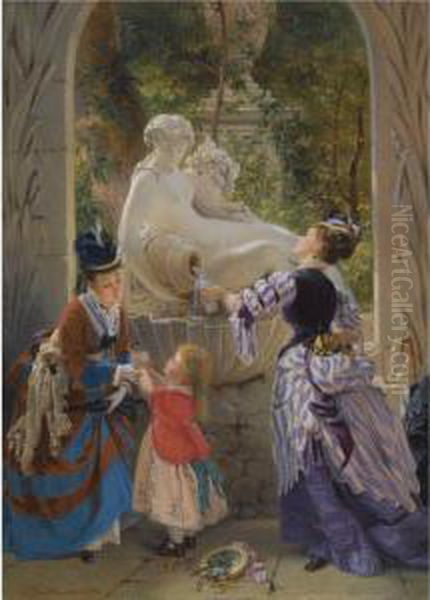
One of his most famous works in this vein is An Elegant Billiard Player (sometimes titled The Elegant Billiard Player or A Game of Billiards), painted around 1869. This painting showcases his skill in depicting contemporary costume and creating a scene of sophisticated leisure. The central figure, a woman poised to take a shot, is rendered with grace and concentration. The rich interior, the fashionable attire, and the subtle narrative of the game itself are all characteristic of Boutibonne's strengths. Such scenes of modern life, albeit idealized, found favor with Salon audiences and private collectors. Artists like Alfred Stevens, a Belgian painter highly successful in Paris, and James Tissot also specialized in depicting fashionable women in contemporary settings, and Boutibonne's work shares affinities with theirs, though perhaps with a slightly more conservative or classical leaning.
Boutibonne also explored historical and mythological themes, though these are less central to his recognized oeuvre than his society portraits and genre scenes. A work like Turkish Odalisque (1880) indicates an engagement with Orientalism, a popular theme in 19th-century art where artists depicted scenes from the Middle East, North Africa, and the Ottoman Empire, often emphasizing the exotic and sensual. Gérôme was a master of this genre, and Boutibonne's foray into it reflects a broader artistic trend. His reported depiction of mermaids not as mythical half-fish creatures but as realistic female divers in Mermaids Frolicking in the Sea (or Sea Nymphs) suggests an interesting, perhaps more naturalistic or modern, take on a typically fantastical subject. Other works attributed to him, such as La Fontaine (The Fountain) and Mountain Climbers, indicate a breadth of subject matter that also included landscape and outdoor scenes.
Notable Works: A Closer Look
Several paintings stand out in Charles Édouard Boutibonne's body of work, exemplifying his style and thematic preoccupations.
L'Impératrice Eugénie: While specific versions and titles can vary (sometimes referred to as Portrait of Empress Eugénie or similar), his depictions of the Empress were significant. These portraits would have been executed with the utmost care, aiming to capture not only her likeness but also her imperial status and her role as a leader of fashion. The Empress was a key patron of the arts and her image was widely disseminated. Boutibonne's contributions to her iconography would have placed him in the company of other favored court painters like Winterhalter. These works are characterized by their luxurious rendering of gowns, jewels, and the regal bearing of the sitter.
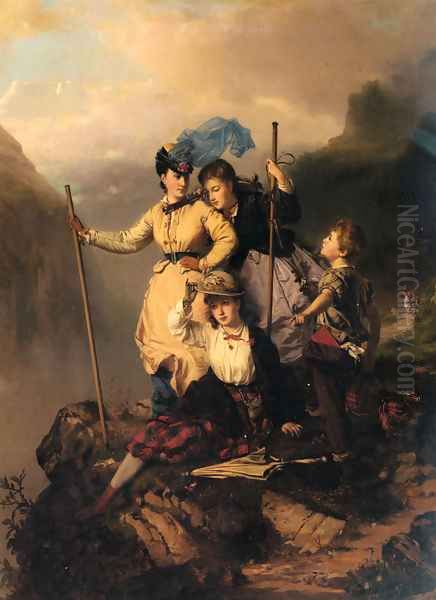
An Elegant Billiard Player (c. 1869): This is perhaps one of his most frequently reproduced genre scenes. It epitomizes the elegance and leisure of Second Empire society. The painting is notable for its detailed depiction of the billiard room, the fashionable attire of the figures, particularly the woman in a striking striped dress, and the sense of suspended action. It speaks to the increasing, though still somewhat unconventional, participation of women in certain leisure activities. The careful rendering of textures, from the sheen of the billiard balls to the richness of the fabrics, is a hallmark of Boutibonne's technique.
La Comtesse de Beaune: This portrait is often cited as showing the influence of Franz Xaver Winterhalter. It would likely feature a noblewoman portrayed with the elegance and refinement typical of both artists, emphasizing her social standing through pose, costume, and setting. Such works catered to the desire of the aristocracy and wealthy bourgeoisie to have their status immortalized in a manner that was both flattering and artistically accomplished.
Riding the Waves (1874) and Mermaids Frolicking in the Sea: These titles suggest an interest in marine themes and the human figure in motion, possibly in coastal or beach settings which were becoming popular leisure destinations. If the "mermaids" were indeed depicted as naturalistic female swimmers, it would represent a departure from traditional mythological portrayals and align with a more modern, perhaps even slightly daring, sensibility for the time, focusing on the vitality of the human body in a natural environment.
Turkish Odalisque (1880): This work places Boutibonne within the Orientalist tradition. An "odalisque" was a female slave or concubine in a harem, a subject that allowed artists to explore themes of the exotic, the sensual, and the "other." Artists like Ingres (with his famous Grande Odalisque), Delacroix, and Gérôme extensively mined this theme. Boutibonne's version would likely feature a reclining female figure in an opulent, Eastern-inspired setting, rendered with his characteristic attention to detail and refined finish.
The Academic Milieu and Its Challenges
Boutibonne thrived within the Academic system. The Académie des Beaux-Arts, through its control of the École des Beaux-Arts (the premier art school) and the Paris Salon, largely dictated artistic taste and standards for much of the 19th century. The system valued history painting above all other genres, followed by portraiture, genre painting, and landscape. Technical proficiency, adherence to classical ideals of beauty, and morally uplifting or historically significant subject matter were highly prized.
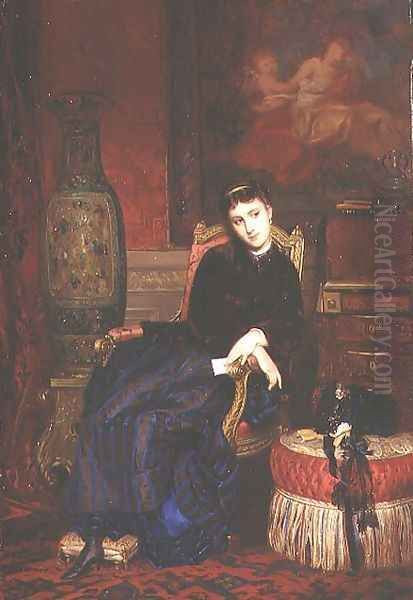
Artists like Paul Delaroche, a successful historical painter, and Thomas Couture, whose Romans of the Decadence was a Salon sensation and who taught artists like Édouard Manet, represented the established order. Boutibonne's work, with its polished technique and elegant subject matter, fit comfortably within these established norms. He provided patrons with beautifully crafted images that affirmed their social status and aesthetic preferences.
However, during Boutibonne's career, this Academic dominance faced increasing challenges. The Realist movement, championed by Courbet, rejected Academic idealism in favor of depicting ordinary people and everyday life, often with a critical social edge. Later, the Impressionists, including Monet, Renoir, Degas, Camille Pissarro, Berthe Morisot, and Alfred Sisley, revolutionized painting with their emphasis on capturing fleeting moments, the effects of light and atmosphere, and subjective visual experience, often painting en plein air (outdoors) with visible brushstrokes. Their first independent exhibition in 1874, an alternative to the official Salon, marked a turning point in modern art.
Boutibonne, like many of his Academic colleagues, did not embrace these radical new directions. His art remained a testament to the enduring appeal of traditional craftsmanship and idealized representation. While this meant he was not an avant-garde innovator, his work fulfilled a significant cultural role, satisfying the tastes of a powerful segment of society.
Later Years and Legacy
In the later part of his career, Charles Édouard Boutibonne continued to paint, maintaining his refined style. He spent his final years in Switzerland, a country known for its scenic beauty, which may have appealed to his artistic sensibilities. He passed away in Wilderswil, Switzerland, in 1897, at the age of 81. His connection to Switzerland was also formalized by his membership in the Bern Art Association (Berner Kunstgesellschaft) from 1867, indicating his standing within artistic circles beyond Paris.
Today, Charles Édouard Boutibonne is remembered as a skilled and elegant painter of the French Academic school. His works are held in various private and public collections and occasionally appear at auction, where they are appreciated for their charm, technical finesse, and as evocative documents of a bygone era of aristocratic grace. While the grand narratives of art history often focus on the revolutionary figures who broke with tradition, artists like Boutibonne played a crucial role in the artistic ecosystem of their time. They upheld standards of craftsmanship, catered to the tastes of influential patrons, and created a body of work that, while perhaps stylistically conservative from a modernist perspective, possesses its own distinct beauty and historical value.
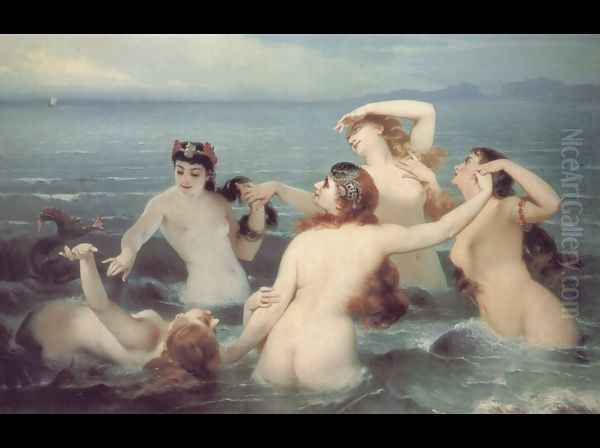
His portraits and genre scenes offer a glimpse into the opulent world of the Second Empire and late 19th-century European high society. They speak of a time when elegance was highly prized, and art served to reflect and reinforce the values and aspirations of the elite. In his meticulous rendering of fashion, his graceful portrayal of figures, and his ability to create harmonious and pleasing compositions, Boutibonne demonstrated a mastery that earned him respect in his lifetime and ensures his work continues to be admired.
Conclusion: An Enduring Elegance
Charles Édouard Boutibonne navigated the competitive art world of 19th-century Paris with considerable success. From his training under distinguished masters like Friedrich von Amerling and Achille Devéria to his regular participation in the Paris Salon and his commissions from high society, including royalty, he established himself as a painter of note. His artistic legacy lies in his elegant portrayals of an era defined by its pursuit of refinement and luxury.
While the tides of artistic taste eventually shifted towards Modernism, the appeal of Boutibonne's work endures. His paintings are more than just historical documents; they are testaments to a high level of technical skill and a sophisticated aesthetic sensibility. Works like An Elegant Billiard Player and his portraits of Empress Eugénie capture the spirit of their age with a charm and polish that continue to engage viewers. As an art historian, one appreciates Boutibonne not for radical innovation, but for his mastery within the established Academic tradition, his contribution to the genre of society portraiture, and his ability to imbue his canvases with a timeless elegance that transcends the specific historical moment of their creation. He remains a significant representative of a particular strand of 19th-century European art that valued beauty, craftsmanship, and the refined depiction of contemporary life.